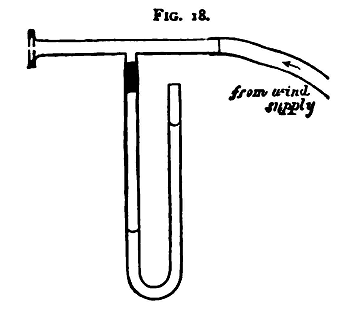| Practical Physics is a free textbook on basic laboratory physics. See the editorial for more information.... |

|

Home  Acoustics Acoustics  Determination of the Wave-length by means of a Flame. Determination of the Wave-length by means of a Flame. |
||||||||||






|
||||||||||
Determination of the Wave-length by means of a Flame.
For this experiment a note of very high pitch is required. Probably a very high organ-pipe or whistle might be employed, but a simple and convenient arrangement, the same in principle as 'bird-call' consists of two small parallel metallic discs, fixed so as to be a short distance - a millimetre more or less - apart, and perforated, each with a small circular hole the one behind the other. This pair of discs is then fixed on to the end of a supply-tube, and air blown through the holes by means of a loaded gas bag or bellows. It is convenient to connect a manometer with the supply-tube, close to the whistle, in order to regulate the supply of air from the reservoir, and thus maintain a note of constant pitch.
Fig. 18 shows a section of this part of the apparatus. It is very easily constructed. The one disc can be fixed to the tube of glass or metal by sealing wax, and the other adjusted and kept in its place with soft wax. A sensitive gas flame 'flares' when a note of sufficiently high pitch is soynded in its neighbourhood; thus a hiss or the shaking of a bunch of keys is generally effective. To obtain a sensitive flame, a pin-hole steatite burner may be employed; it must be supplied with gas at a high pressure (9 or 10 inches of water) from a gas holder. The ordinary gas supply of a town, which gives only about 1 inch pressure, is of no use for the purpose.
In order to determine the wave-length of a note by this apparatus, a board is placed so that the sound is reflected perpendicularly from its surface Placing the nozzle of the burner in the line from the source of sound perpendicular to the board, and moving the burner to and fro along this line, a series of positions can be found in which the effect of the sound upon the flame is a minimum. The positions are well-defined, and their distances from the board can be measured by taking the distances between the board and the orifice of the burner with a pair of compasses, and referring them to a graduated scale. These positions correspond to the nodal points formed by the joint action of the incident vibration and the vibration reflected from the surface of the board. The distance between consecutive positions corresponds accordingly to half a wave-length of the incident vibration. The wavelength of the note sounded is, therefore, twice the distance between consecutive positions of minimum effect upon the flame. The distances of as many successive positions as can be accurately observed should be taken. Each observation should be repeated three or four times and the mean taken. Instead of the sensitive flame, an india-rubber tube leading to the ear may be employed, and positions of silence determined. It must be remembered, however, in this case that the position of silence for the ear corresponds to a position of minimum pressure-variation at the orifice of the tube - that is to say, to a loop and not to a node. The distances of these positions of silence from the wall are, therefore, odd multiples of quarter-wave-lengths instead of even multiples, as when the sensitive flame is used. Experiment - Determine the wave-length of the given note by means of a sensitive flame. Enter results thus:
Mean wave-length = 31.2 mm
|
||||||||||
Home  Acoustics Acoustics  Determination of the Wave-length by means of a Flame. Determination of the Wave-length by means of a Flame. |
||||||||||
Last Update: 2011-03-27


